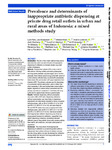2021-08-03Zeitschriftenartikel
Prevalence and determinants of inappropriate antibiotic dispensing at private drug retail outlets in urban and rural areas of Indonesia: a mixed methods study
Luh Putu Lila, Wulandari
Khan, Mishal
Liverani, Marco
Ferdiana, Astri
Mashuri, Yusuf Ari
Probandari, Ari
Wibawa, Tri
Batura, Neha
Schierhout, Gill
Kaldor, John
Guy, Rebecca
Law, Matthew
Day, Richard
Hanefeld, Johanna
Parathon, Harry
Jan, Stephen
Yeung, Shunmay
Wiseman, Virginia
Introduction: The aim of this mixed-method study was to determine the extent and determinants of inappropriate dispensing of antibiotics by licensed private drug retail outlets in Indonesia.
Methods: Standardised patients (SPs) made a total of 495 visits to 166 drug outlets (community pharmacies and drug stores) between July and August 2019. The SPs presented three clinical cases to drug outlet staff: parent of a child at home with diarrhoea; an adult with presumptive tuberculosis (TB); and an adult with upper respiratory tract infection (URTI). The primary outcome was the dispensing of an antibiotic without prescription, with or without the client requesting it. We used multivariable random effects logistic regression to assess factors associated with the primary outcome and conducted 31 interviews with drug outlet staff to explore these factors in greater depth.
Results: Antibiotic dispensing without prescription occurred in 69% of SP visits. Dispensing antibiotics without a prescription was more likely in standalone pharmacies and pharmacies attached to clinics compared with drug stores, with an OR of 5.9 (95% CI 3.2 to 10.8) and OR of 2.2 (95% CI 1.2 to 3.9); and more likely for TB and URTI SP-performed cases compared with child diarrhoea cases, with an OR of 5.7 (95% CI 3.1 to 10.8) and OR of 5.2 (95% CI 2.7 to 9.8). Interviews revealed that inappropriate antibiotic dispensing was driven by strong patient demand for antibiotics, unqualified drug sellers dispensing medicines, competition between different types of drug outlets, drug outlet owners pushing their staff to sell medicines, and weak enforcement of regulations.
Conclusion: This study shows that inappropriate dispensing of antibiotics by private drug retail outlets is widespread. Interventions will need to address not only the role of drug sellers, but also the demand for antibiotics among clients and the push from drug outlet owners to compete with other outlets.
Dateien zu dieser Publikation

